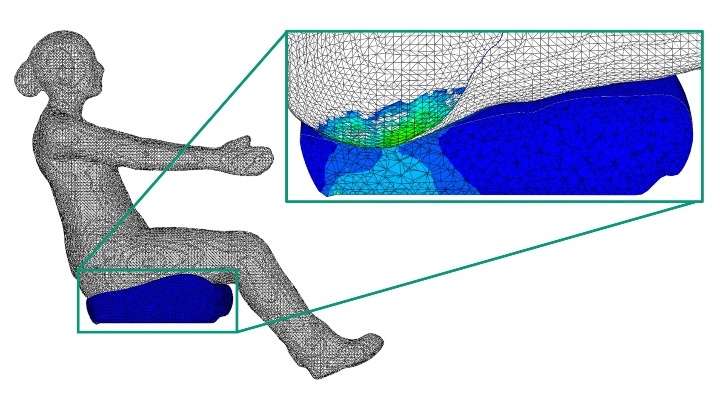Relaxing, working, watching movies: Once cars start driving themselves, drivers can make good use of the way to work. To ensure that ergonomics and safety are not neglected, researchers from the University of Stuttgart, the Fraunhofer Institute for Industrial Mathematics (ITWM) and the company fleXstructures (both Kaiserslautern) are jointly developing a muscle-activated human model that can be used to dynamically simulate how driving maneuvers affect the interaction of human soft tissues and the vehicle seat. The German Research Foundation DFG is funding the project within the framework of the new line of trilateral transfer projects.
Theresia Bauer, Baden-Württemberg's Minister of Science, congratulates the project partners: "I am very pleased that the University of Stuttgart is one of six projects to receive funding from the DFG and the Fraunhofer-Gesellschaft for its project 'EMMA4Drive - Dynamic Human Model for Autonomous Driving'. This once again proves the transfer strength of the University of Stuttgart also with regard to the Stuttgart way - forward-looking research comes directly into application here and strengthens the cooperation between science and industry, which we as a state also intensively promote and advance.
So far, human models have been used either in crash simulations to estimate the risk of injury or in ergonomics analyses. In crash analyses, detailed, computationally intensive FE models are used for calculations in the millisecond range. However, these models are not suitable for the simulation of dynamic driving maneuvers, because here longer processes have to be simulated. Human models for ergonomics analysis, on the other hand, are based on simplified movement mechanisms and so far only allow quasi-static investigations. Realistic postures and movements during new activities can only be simulated with these models with a lot of effort.
Confidence in technology and strengthening its safey
New (software) tools are needed to understand customer expectations for (partially) autonomous driving, to explore new ways of using the car, to strengthen trust in the technology and to prove its safety. Against this background, the group around Prof. Jörg Fehr, researcher in the Cluster of Excellence "Data Integrated Simulation Science (EXC 2075, SimTech) and deputy director of the Institute of Engineering and Computational Mechanics (ITM) at the University of Stuttgart, wants to create the software prototype EMMA4Drive, which as a digital image of the occupant is able to analyze and evaluate safety and ergonomics equally during driving maneuvers under dynamic loads.
Extensive preliminary work by SimTech and others
To this end, scientific findings from projects of the Cluster of Excellence 310, the predecessor of EXC 2075, are to be transferred to the muscle-activated multi-body human model EMMA (Ergo-dynamic Moving Manikin) and further developed for use in (partially) autonomously moving vehicles of the next generation. The ITWM around project leader Joachim Linn, contributes to the project expert knowledge about multi-body based human modeling and motion optimization. The prototypical human model EMMA developed there is capable of automatically calculating new postures and motion sequences with the associated muscle activities by means of an optimization algorithm and provides a very efficient model for a stable dynamic simulation with large time step sizes. The company fleXstructures is currently responsible for the development, maintenance and distribution of the software family IPS including the digital human model IPS IMMA.
Expert Contact:
Apl. Prof. Jörg Fehr, Universität Stuttgart, Institut für Technische und Numerische Mechanik und Exzellenzcluster und SimTech, Tel.: +49 (0)711/685 66392, E-Mail




